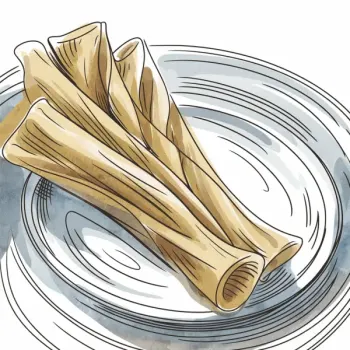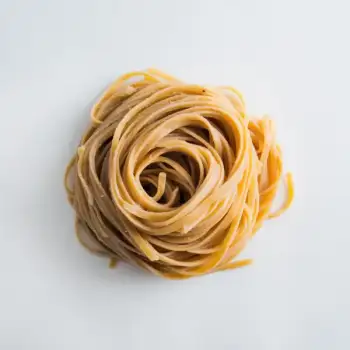Bucatini and Fettuccine are both types of pasta used in Italian cooking, with bucatini being a thick, hollow spaghetti and fettuccine being flat, wide noodles. Each pairs best with different sauces due to their unique shapes and textures.

Bucatini is a thick spaghetti-like pasta with a hole running through the center, commonly used in traditional Italian dishes. It's perfect for hearty sauces that cling to the pasta's substantial structure.

Fettuccine is a type of pasta that is flat and wide, traditionally made fresh. It is commonly paired with rich and creamy sauces that coat the wide surface area, providing a satisfying bite.
The primary differences lie in their shape and the sauces they are best paired with. Bucatini, being a thick, straw-like pasta, is ideal for thicker sauces that can get inside and around the pasta, while fettuccine's flat and wide shape pairs well with creamy sauces. The texture of bucatini offers a more substantial chew, whereas fettuccine provides a wider, flatter surface that carries creamy textures well.

Your ultimate Recipe Box, Meal Planner, and Cooking Class all in one
Bucatini is famously used in 'Bucatini all'Amatriciana', a dish with a rich tomato sauce and guanciale. The hollow center of bucatini allows it to capture the sauce, delivering a flavorful bite. It’s also great in 'Bucatini alla Carbonara', where the egg and pancetta sauce is captured inside the pasta. Fettuccine shines in 'Fettuccine Alfredo', where its flat noodles luxuriously carry the creamy Alfredo sauce. Additionally, 'Fettuccine ai Funghi' with a rich mushroom cream sauce highlights the pasta’s ability to pair with earthy flavors.
Bucatini stands up to thick, meaty sauces such as 'Bolognese' where its robust structure complements the ragù's heartiness. Fettuccine pairs well with lighter meat sauces, like a 'Fettuccine with Chicken Ragù', where the broad noodles support the delicate pieces of chicken.
For seafood, bucatini can be used in dishes like 'Bucatini with Anchovy Sauce', where the hollow pasta absorbs the briny flavors of the anchovies. Fettuccine complements seafood well in dishes such as 'Fettuccine ai Frutti di Mare', where the pasta provides a substantial background to the variety of seafood.
Both bucatini and fettuccine are similar in calorie content and provide a good amount of protein and carbohydrates, with negligible differences.
| Nutrient | Bucatini ( per 100g ) | Fettuccine ( per 100g ) |
|---|---|---|
| Fat | 1.5g | 1.5g |
| Fiber | 3.2g | 3g |
| Sodium | 6mg | 6mg |
| Protein | 13g | 12g |
| Calories | 371 | 370 |
| Carbohydrates | 75g | 74g |
You can, but fettuccine won't capture the sauce in the same way that bucatini will, potentially altering the traditional experience of the dish.
Fettuccine is generally preferred for creamy sauces due to its wide, flat surface that holds onto cream-based textures well.
Cook bucatini in a large pot of boiling salted water for about 8-10 minutes, or until al dente, stirring occasionally to prevent sticking.
While they can be substituted for each other, the resulting texture and sauce pairing will be different due to their distinct shapes.
Fettuccine is most suitable for dishes with creamy, buttery, or light tomato-based sauces, such as Fettuccine Alfredo or Fettuccine with a simple cherry tomato sauce.